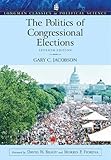The politics of congressional elections/ Gary C. Jacobson ; with foreword by David W. Brady, Morris P. Fiorina.
Material type: TextSeries: Longman classics in political sciencePublication details: New York : Pearson/Longman, c2009Edition: 7th edDescription: xiv, 290 p. : ill. ; 24 cmISBN: 0205577024; 9780205577026Subject(s): United States. Congress | ElectionsDDC classification: 324.973
TextSeries: Longman classics in political sciencePublication details: New York : Pearson/Longman, c2009Edition: 7th edDescription: xiv, 290 p. : ill. ; 24 cmISBN: 0205577024; 9780205577026Subject(s): United States. Congress | ElectionsDDC classification: 324.973 | Item type | Current library | Call number | Status | Date due | Barcode | Item holds |
|---|---|---|---|---|---|---|
|
|
Central Library, Sikkim University General Book Section | 324.973 JAC/T (Browse shelf(Opens below)) | Available | P18219 |
Includes bibliographical references (p. 271-283) and index.
Chapter 1-Introduction
Chapter 2-The Context
The Constitutional Framework
Congressional Districts
Partisan Gerrymandering
Redistricting Between Censuses
Racial Gerrymandering
The Republican Advantage in House Districts
States as Electoral Units
Election Laws
Political Parties
Social and Political Contexts
Chapter 3-Congressional Candidates
The Incumbency Factor
Measuring the Value of Incumbency
The Vanishing Marginals
Sources of the Incumbency Advantage
The Institutional Characteristics of Congress
Changes in Voting Behavior
Constituency Service
The Variability of the Incumbency Advantage
Discouraging the Opposition
Money in Congressional Elections
The Connection between Money and Success
Why Campaign Money Is More Important to Challengers than to Incumbents
The Career in the District
Motivating Challengers
Notes
Chapter 4-Congressional Campaigns
Campaign Money
Contributions to Candidates
PACs
Party Money
Contributions from Other Members of Congress
Self-Financing by Candidates
Fundraising Tactics
Independent, "Voter Education," and "Issue Advocacy" Campaigns
Campaign Organizations
Campaign Strategies
Campaign Media
Personal Campaigning
Campaign Messages
Challengers' Campaigns
Going Negative
Incumbents' Campaigns
Candidates for Open Seats
Senate Campaigns
Manipulating Turnout
Concluding Observations
Chapter 5-Congressional Voters
Turnout in Congressional Elections
Who Votes?
Partisanship in Congressional Elections
Alternative Interpretations of Party Identification
Partisanship and Voting
Information and Voting
Recall and Recognition of Candidates
Contacting Voters
The Effects of Campaign Spending
Models of Voting Behavior
Evaluating Incumbents
Winning Challengers
Issues in Congressional Elections
Chapter 6-National Politics and Congressional Elections
Political Interpretations of Congressional Elections
Models of Aggregate Congressional Election Results
Presidential Coattails
National Conditions and Strategic Politics
Campaign Themes
House Elections, 1992-2006
1992
1994
The Clinton Problem
Nationalizing the Vote
1996
The Campaigns
1998
The Scandal and the Campaigns
2000
2002
The Economy xxx
Exposure and Redistricting
2004
2006
Strategic Politicians in 2006
Conclusion: House Election Patterns, 1980-2006
Senate Elections, 1980-2006
2002-2006
Maintaining the Balance
Chapter 7- Elections, Representation, and the Politics of Congress
Representation
Policy Congruence
Interests and Causes
Representation by Referendum
Descriptive Representation
Policy Consequences
Particularism
Serving the Organized
Responsiveness without Responsibility
The Congressional Parties: Decline and Revival
The Revival of Party Cohesion, 1980-2006
Ideological Polarization in Congress and the Electorate
Polarization in Presidential Support
Party Polarization: The Electoral Connection
Diverging Electoral Constituencies
Chicken or Egg?
Party Polarization and the Politics of Impeachment
Representing Polarized Opinions on the Iraq War after 2006
Reforming Congress
Term Limits
The Public's Evaluations of Congress
2008 and Beyond: A Matter of Geography


There are no comments on this title.